The Secret Life of Flores
Eastern Indonesia
World class diving, snorkelling above colourful reefs off tiny coral atolls in seas more shades of blue than there are adjectives for in the Oxford English Dictionary, ikat weaving, traditional villages, hot springs, komodo dragons, active volcano trekking, breathtaking volcanic lakes.
Flores may be one of the less frequently visited islands in eastern Indonesia, but it still has a very well defined tourist trail taking in all of the above and more. The trail follows the amusingly named Trans-Flores Highway, winding and often little more than single track in places, using dilapidated but frighteningly fast 23-seat minibuses.
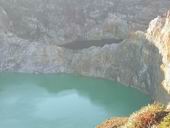

“young men and maidens”
![]()
![]()
![]()
![]()
![]()
![]()
![]()
Armed with four pages cut from an out of date guide to South East Asia and a recently acquired 2000 word vocabulary in Bahasa Indonesia, I flew from Bali to Maumere in the east of Flores, then spent a leisurely three weeks making my way back by bus and boat. Very high on my list of “must-sees” were the two sets of coloured volcanic lakes, three at Kelimutu near Moni, and five at Wawo Muda near Bajawa.
Kelimutu. Day One. 3.30 a.m. It looked promising. Wrong. By the time we reached the main viewpoint at 4.30, we were surrounded by clouds which had come down like a grey blanket. Worse, it was wet. If you’re English, we had mizzle, hanging drizzle, penetrating drizzle and light rain in the space of half an hour. If you’re not English, it just rained. The nearest lake, dark green in colour, condescended to make an appearance beneath us for about thirty seconds.
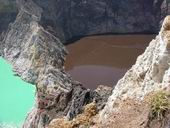

The enchanted lake
![]()
![]()
![]()
![]()
![]()
![]()
![]()
Day Two. 3.30 a.m. Filled with expectation I answered the knock on my door to find that it was raining. Actually, it was hosing down. I smiled at the driver and said, “Tidak mau ke atas, tidak ada guna, mau tidur lagi.” (Literally, “not to want to up, not have use, to want to sleep again” – it’s such an easy language to learn.) At 6.00 he knocked again. It had almost stopped raining, but cloudbase was still below the village and Kelimutu was several hundred metres above, so I went back to bed. The other guests, rather more pressed for time, did go up. Later, over breakfast, they reported that they had briefly seen just part of the dark green lake. I tried not to feel smug.
Day Three. 3.30 a.m. Again. At last it looked as if my patience was about to be rewarded. In the car park below the summit we stopped for a cup of something that was almost, but not entirely, quite unlike coffee. “This coffee tastes like mud!” “That’s strange, sir. It was only ground this morning.” A shooting star streaked to its oblivion overhead, and one of the locals told me it was a sign that we’d have a good view of the lakes. The complete absence of clouds suggested there was little chance he’d be proved wrong.
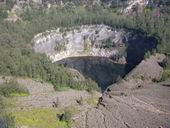

“Lake of the Elders”
![]()
![]()
![]()
![]()
![]()
![]()
![]()
We walked up by torchlight and arrived at the viewpoint just as the eastern sky was beginning to brighten. In the soft early morning light we could finally see all three lakes. The nearest is called Tiwu Nua Muri Koohi Fah (TiN), or “the lake of young men and maidens”. As on day one, it was a very deep green. It used to be turquoise. Beyond, only just visible, Tiwu Ata Polo (TAP), the “enchanted (or bewitched) lake” looked like black coffee. Over time, it has been deep green through maroon to very dark brown. Behind us, Tiwu Ata Mbupu (TAM), “the lake of elders” was jet black.
By 7.00, most of the visitors were walking back to the car park, unwilling to face a 13km hike down the mountain later. A few of us elected to stay. Then the sun hit TiN. The dark green was magically transformed to a milky jade. Wisps of steam played on its surface. On the far side, the water appeared to be moving as if heated up from below. Once in sunlight, TAP changed from dark coffee to hot chocolate (actually, at 35°C, more like tepid chocolate). And TAM, its surface completely still, now looked exactly like a famous cola.
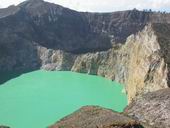

TiN in the sun
![]()
![]()
![]()
![]()
![]()
![]()
![]()
The Question
Three crater lakes, very close together above one volcano, but three completely different colours, which keep changing. Why? Guide books and most locals, in order to create and maintain an aura of mystery and suspense, will tell you that no one knows the reasons. Or they’ll tell you the local legend which describes how each lake is the final resting place of different souls – one for young men and maidens, one for elders, one for wicked people. Hmm. Another local piece of wisdom relates how the lakes don’t actually change colour at all – it’s an optical illusion. Sometimes you’ll get “it’s something to do with the minerals …” Dissatisfied with the explanations, I spent some time online and found numerous technical reports about volcanic lakes in general and Kelimutu in particular, filled with esoteric vocabulary and accounts of detailed research using remote sampling devices and sophisticated chemical analysis.
The Solution
Actually, it’s a suspension. Kelimutu is a passively degassing stratovolcano, and the three lakes are simply rainwater. Each lake sits on top of a differently active fumarole (gas vent) which introduces sulphur dioxide and circulates the water. TiN, which is actually sulphuric acid with a pH of about 0.3, has a very active vent. In 1994 one study estimated it was receiving around 85 tonnes of sulphur dioxide a day. TAM receives the least gaseous input of the three. The green colour comes from a combination of exotic sulphur compounds from the volcanic gases, barium, copper and arsenic precipitates and a low level of oxidation. The addition of oxygen rich rainwater introduces ferric oxide precipitates causing the colours to change from green through deep red to black. The more active the fumarole, the more the precipitates are circulated, and the influence of the oxidation counteracted. Simple, really.
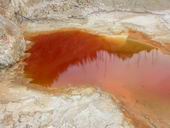

Wawo Muda
![]()
![]()
![]()
![]()
![]()
![]()
![]()
The Red Lakes
A few days later I took a bemo (small local minibus) from Bajawa market up to a village called Ngorenale. The local fare should have been 1000rp but the driver dropped me off at the end of the track to the lakes instead of in the village, and explained clearly and very helpfully where to go at the top, so I paid him double (about 12p). A gentle uphill stroll under a cloudless sky led to a series of lush green caldera filled with small farms, and there were dramatic views back to the towering Gunung Inerie and other solitary volcanos in the distance. I walked round the top to a more desolate crater. From the lip, the ground below looked as if it had been blasted by a recent explosion. That’s because it had. Wawo Muda erupted in February 2001, and the rainy season produced five small lakes. Unlike Kelimutu, these are not over gaseous vents, and are therefore different shades of red because of the ferric oxide. In August however, after months of evaporation in the unrelenting equatorial sun, two had dried up completely, leaving just three.
Making my way carefully, precariously, around the edge, I noticed a very faint line running down the opposite slope. To call it a path would have been overly generous. Steep, loose, I took it anyway …
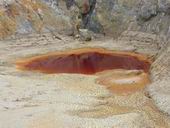

Wawo Muda
![]()
![]()
![]()
![]()
![]()
![]()
![]()
I stood on the crater floor, the ground beneath me cracked and pitted, the few remaining trees ashen and lifeless. Many of the rocks were curiously tinged with sulphurous yellow. Cautiously I walked right up to one of the lakes – a deep, vivid coral orange. Remembering that the green lake at Kelimutu was actually sulphuric acid, (and having seen the dissolving boat scene with Pierce Brosnan in Dantes Peak!) I easily resisted the temptation to put my hand in the water. The middle lake, smaller and less easily accessible, was blood red. I wandered around the surreal landscape for more than an hour, then retraced my steps to the village before the last bemo left. There, in another of those typical, now familiar acts of Indonesian generosity, a truck driver picked me up. He was delivering some large brown bags containing “semen”. That’s the Indonesian word for cement, by the way. He didn’t want anything in return, except to practise his English with my help, which I did willingly, until he dropped me off at my hotel, just in time for dinner.